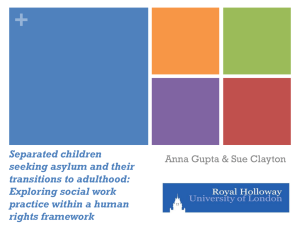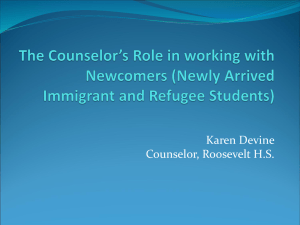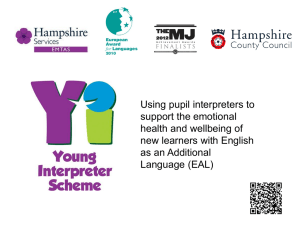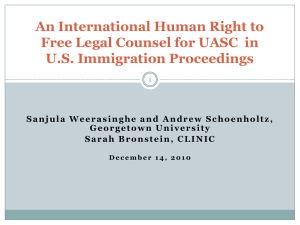SK Conference_Working with UASC
advertisement
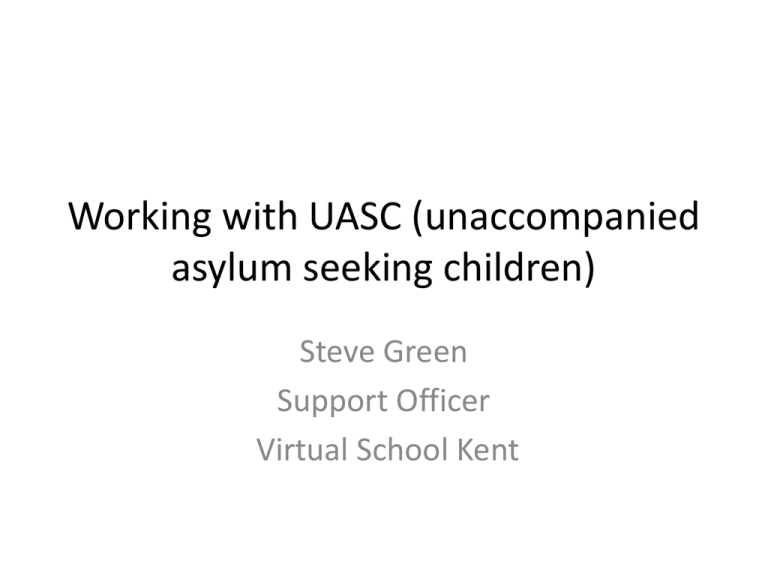
Working with UASC (unaccompanied asylum seeking children) Steve Green Support Officer Virtual School Kent Refugee or Asylum seeker ? • Refugee:-a person with defined refugee status has fled his home country and is unable to return due to a well founded fear of being persecuted for reasons of race, religion, nationality, membership of a social/political group • Asylum seeker:- is a person who has crossed an international border in search of safety and refugee status-(Asylum seeking children make up around 6% of LAC) DCSF (2009) UASC • • • • • • • Some of the most at risk children in care because:Many enter the country without adult supervision Able to speak little or no English Limited or disrupted education May have endured traumatic events, war, rape, loss, etc May have no one to care for them in their home country May have experienced persecution or hardship that has led to disturbed behaviour • May have lost family, friends, belongings and experienced shortages of food and necessities UASC (cont) • May have experienced rape, torture or forced to join armies/militia • Traumatic experiences can result in strong emotional reactions • Lost of contact with family/friends in home country • Maybe unsure of protocols/customs regarding practising faith in UK Good practice- Key Messages • The best place for EAL students is in the mainstream classroom. Language support for children new to English should be based around the language they need to access the curriculum • EAL learners should be given opportunities to use their first language for learning • The learning context can be made more supportive via scaffolding activities • Teachers need to identify language demands of lessons, and plan opportunities to use at least some of that language in meaningful way • Children new to English need to be provided with achievable tasks that provide appropriate age related cognitive demands • Bilingualism is an asset and first language has a continuing role in identity, and learning • Induction is important; ensure carers/UASC are shown around and any possible differences explained (interpreters used) Good Practice-Key Messages (cont) • Buddies can help if they either speak the same language or alternatively are sympathetic to the needs of UASC • Ensure schools inform carers of their rights to free school meals, travel, school milk uniform etc • Try to access a bilingual classroom assistant when the child starts school • Provide background information/training to all staff involved with admissions about new UASC • Ensuring UASC pupils progress is reassessed and monitored regularly • Make sure all staff have copies of any baseline education assessments, and that the UASC is interviewed about past educational experiences • Make sure pupils receive welcome materials, such as map of local area, plan of school, name of class teacher, timetable , details of any buddy • Ensure there are opportunities for UASC who are not coping well to be withdrawn to small groups/one to one tuition or mentoring Rutter, J (1999)Refugee children in the UK, OU Press Rutter , J , (2001) ,Supporting Refugee Children in 21st Century Britain, Trentham Books What we do at VSK ! • • • • • Provide baseline education assessments on all new arrivals Contribute to Social Services Age assessments Provide initial transitioning support to UASC starting school Attend LAC and PEP reviews Provide support and advice to UASC school leavers/16+ regarding F.E.,ESOL courses, community support agencies • Provide advice to foster carers around suitable educational materials • Provide additional educational work for 16+ UASC at the Millbank Reception Centre Protective factors • Strong home support from carers, that reinforces and compliments the work of school • An understanding by staff of why they had to leave, and maintaining wherever possible positive links to either their homeland or people from their community in the UK • Being able to build upon their skills/abilities helps UASC to focus on what they are good at What do Ofsted look for ? • EAL pupils are not an homogenous group • Schools should monitor the attainment and progress from the earliest stages of learning English (see Kent steps) • Schools should take steps to assess the learners proficiency and literacy in their first language, and prior subject knowledge • Specialist EAL support should be available for new arrivals from qualified teachers/teaching assistants who have received appropriate training Ofsted (Cont) • Class/subject teachers should plan collaboratively with EAL support teachers/teaching assistants. This should include both a focus on language and subject content • Cognitive challenge should remain high despite increased proficiency in English language • Any withdrawal from class should be for a specific purpose, time limited and linked to work of the mainstream class. Subject teachers need to be involved in this • School development plans should have clear objectives and strategies for EAL learners • There should be regular training for staff on the needs of EAL learners • Any additional funding for EAL learners should be deployed to support new arrivals and advanced learners • (See examples of good practice handout, Primary/Secondary)
